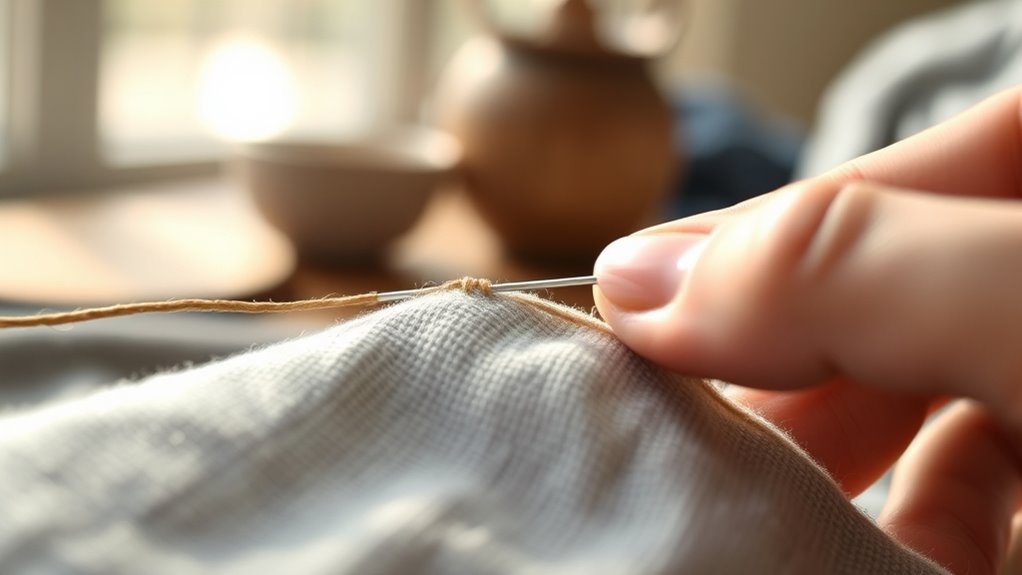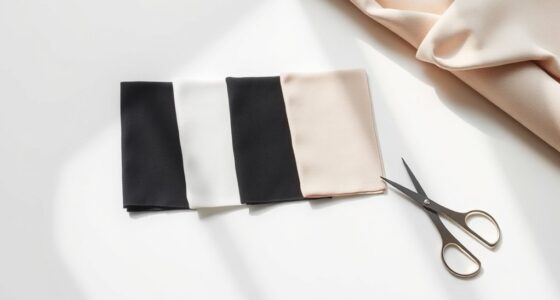Practicing stitch meditation turns sewing into a calming ritual that helps lower stress one needle pass at a time. By focusing your attention on each stitch—feeling the fabric, hearing the sound, and noticing the rhythm—you cultivate mindfulness and stay present. This simple act quiets a busy mind and promotes relaxation. Keep exploring, and you’ll discover how to transform your sewing practice into a powerful self-care tool that nurtures calm and clarity.
Key Takeaways
- Mindful stitching transforms sewing into a meditative practice that promotes relaxation and reduces stress.
- Focusing on each stitch enhances present-moment awareness, calming the mind and lowering anxiety levels.
- Incorporating needle mindfulness into sewing routines can improve mental clarity and emotional resilience over time.
- Choosing simple projects and dedicating uninterrupted time helps deepen the stress-relief benefits of stitch meditation.
- Regular practice fosters a peaceful state, connecting self-care with mindful sewing to support overall well-being.

Have you ever wondered how combining mindfulness with sewing can boost your mental well-being? It might sound unusual at first, but integrating mindful stitching into your routine can transform a simple hobby into a powerful tool for relaxation. When you focus on each stitch, you engage in a practice known as needle mindfulness—being fully present with every movement of your hand and needle. This deliberate attention helps quiet a busy mind and cultivates a sense of calm. Instead of rushing through your sewing project, you slow down, savoring each pass of the needle and the tactile sensation of thread slipping through fabric. This act of focused attention turns your sewing into a form of meditation, allowing you to disconnect from daily stressors and reconnect with the here and now.
Transform your sewing into a calming meditation by focusing fully on each stitch and embracing needle mindfulness.
Mindful stitching isn’t just about crafting; it’s about creating a moment of mental clarity. As you sit with your project, you become aware of your breath, your body, and the repetitive motion of your hand guiding the needle. When you practice needle mindfulness, you notice the slight tension in your shoulders, the rhythm of your heartbeat, and the sensation of fabric beneath your fingertips. This heightened awareness helps ground you, anchoring your thoughts to the present instead of spiraling into worries or distractions. Over time, this practice can foster greater patience and emotional resilience, making it easier to handle stressful situations outside the sewing room.
To make the most of stitch meditation, start by choosing a simple project that doesn’t require constant focus, like a straight seam or a basic embroidery pattern. Set aside dedicated time where you won’t be interrupted, and approach your sewing with an open, curious attitude. Pay close attention to the feel of the needle passing through fabric, the sound of thread pulling through stitches, and the visual rhythm of your work. If your mind starts to wander, gently redirect your focus back to the act of stitching. This gentle redirection is essential to needle mindfulness, helping you develop a non-judgmental awareness of your thoughts and sensations. Incorporating sleep and relaxation strategies can further enhance your ability to stay present and mindful during your stitching practice.
Practicing mindful stitching regularly can help you develop a peaceful, meditative state that extends beyond your sewing sessions. It’s a simple yet profound way to lower stress, improve concentration, and foster a deeper connection to your craft. The next time you pick up your needle, remember that each stitch is an opportunity to cultivate mindfulness and nurture your mental well-being. With patience and consistency, your sewing becomes more than just a hobby—it becomes a practice of self-care that soothes your mind one needle pass at a time.
Frequently Asked Questions
Can Stitch Meditation Help With Chronic Anxiety?
You might wonder if stitch meditation can help with chronic anxiety. It’s a form of mindfulness practice that encourages focus on each needle pass, promoting stress reduction. By engaging in stitch meditation, you can experience mindfulness benefits like calming your mind and reducing anxious thoughts. Regular practice helps you stay present, easing the grip of chronic anxiety and fostering a sense of calm and relaxation.
How Long Should Each Session Last for Optimal Benefits?
Your question about ideal session length is essential because, honestly, it can feel like trying to find a needle in a haystack! For best results, follow the duration guidelines of 15-20 minutes per session, allowing your mind to unwind fully. Aim for regularity—daily or several times a week—since consistent practice boosts stress relief and anxiety reduction. You’ll find that this balanced approach creates the most profound, lasting benefits.
Is Prior Sewing Experience Necessary to Practice Stitch Meditation?
You don’t need knitting skills or sewing experience to practice stitch meditation. It’s designed to be accessible for everyone, regardless of your prior sewing skills. You’ll focus on gentle needle passes, which can help lower stress and promote mindfulness. Just follow simple instructions, and you’ll find that your experience with sewing doesn’t matter. It’s all about calming your mind through the rhythmic, soothing motion of stitching.
Are There Any Risks or Contraindications Involved?
Imagine diving into a world of tiny needles and delicate stitches—sounds risky, right? But don’t worry! With needle safety in mind, risks like skin irritation are minimal if you use clean tools and gentle techniques. To avoid contraindications, stop if you experience pain or discomfort. Overall, stitch meditation is safe for most, as long as you’re cautious, keep your needles sterile, and listen to your body.
Can Stitch Meditation Be Combined With Other Relaxation Techniques?
You can definitely combine stitch meditation with other relaxation techniques. Integrating mindfulness and breathing techniques enhances your overall stress relief. As you practice stitch meditation, focus on the present moment and deepen your breath, which amplifies relaxation. This mindfulness integration helps you stay centered, making it easier to manage stress. Combining methods like deep breathing or progressive muscle relaxation with stitch meditation creates a more all-encompassing approach to calming your mind and body.
Conclusion
Imagine feeling calmer after just a few mindful stitches. Like Sarah, who used stitch meditation during hectic workdays, she found herself more centered and less overwhelmed. By focusing on each needle pass, you can similarly transform stress into serenity. It’s a simple practice that fits into any schedule—just a few minutes can make a big difference. So, next time life feels chaotic, try stitching your way to calm and see how peaceful you can become.









